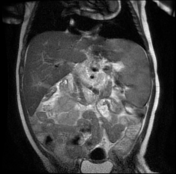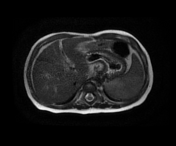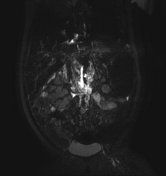Biliary atresia
Diagnosis almost certain
Disclosures
- updated 14 May 2023:
Nothing to disclose
Updates to Case Attributes
Body
was changed:
Biliary atresia is a congenital anomaly in which there is a variable degree of atresia of the extrahepatic biliary ducts. with an incidence of approximately 1:15000 having male prediction.
A baby with congenital atresia is normal at birth, with symptoms starting to develop after 2 weeks to 2 months of age.
Less than 10% of cases present with syndromic conditions such as polysplenia, interrupted IVC, etc.
In this case, the gall bladder is hypoplastic with a length of less than 19 mm, with non-visualisation of the common hepatic duct and common bile duct, and increased periportal signal intensity along with hepatomegaly.
Overall features are consistent with biliary atresia Kasai type 3.
-<p><a href="/articles/biliary-atresia" title="Biliary atresia">Biliary atresia</a> is a congenital anomaly in which there is a variable degree of atresia of the extrahepatic biliary ducts. with an incidence of approximately 1:15000 having male prediction.</p><p>A baby with congenital atresia is normal at birth, with symptoms starting to develop after 2 weeks to 2 months of age.</p><p>Less than 10% of cases present with syndromic conditions such as <a href="/articles/polysplenia-syndrome-1" title="Polysplenia syndrome">polysplenia</a>, interrupted IVC, etc.</p><p>In this case, the gall bladder is hypoplastic with a length of less than 19 mm, with non-visualisation of the common hepatic duct and common bile duct, and increased periportal signal intensity along with hepatomegaly.</p><p>Overall features consistent with biliary atresia <a href="/articles/kasai-classification" title="Kasai classification">Kasai type 3</a>.</p>- +<p><a href="/articles/biliary-atresia" title="Biliary atresia">Biliary atresia</a> is a congenital anomaly in which there is a variable degree of atresia of the extrahepatic biliary ducts. with an incidence of approximately 1:15000 having male prediction.</p><p>A baby with congenital atresia is normal at birth, with symptoms starting to develop after 2 weeks to 2 months of age. Less than 10% of cases present with syndromic conditions such as <a href="/articles/polysplenia-syndrome-1" title="Polysplenia syndrome">polysplenia</a>, interrupted IVC, etc.</p><p>In this case, the gall bladder is hypoplastic with a length of less than 19 mm, with non-visualisation of the common hepatic duct and common bile duct, and increased periportal signal intensity along with hepatomegaly. Overall features are consistent with biliary atresia <a href="/articles/kasai-classification" title="Kasai classification">Kasai type 3</a>.</p>
Diagnostic Certainty
changed from 4 to 3.
Edit Without Moderation
was set to
false.
References changed:
- 1. Norman Williams, Jr., P. Ronan O'Connell, Andrew W. McCaskie. Bailey and Love's Short Practice of Surgery. (2018) ISBN: 9781498796507 - <a href="http://books.google.com/books?vid=ISBN9781498796507">Google Books</a>
- Norman Williams, Jr., P. Ronan O'Connell, Andrew W. McCaskie. Bailey and Love's Short Practice of Surgery. (2018) ISBN: 9781498796507 - <a href="http://books.google.com/books?vid=ISBN9781498796507">Google Books</a>
Systems changed:
- Paediatrics
Updates to Study Attributes
Images Changes:
Image MRI (T2) ( update )

Cropped
image
Image MRI (T2) ( update )

Cropped
image
Image MRI (T2 fat sat) ( update )

Cropped
image
Image MRI (Gradient Echo) ( update )

Cropped
image